JavaScript and TypeScript are both popular programming languages, but they have some key differences.
It is important to understand these differences so that you can make an informed decision about which language to use for your next project.
The purpose of this article is to compare and contrast JavaScript and TypeScript and provide guidance on when to use each language.
Similarities between TypeScript and JavaScript
Both TypeScript and JavaScript have similar syntax, execution, and functionality.
This means that if you are already familiar with JavaScript, you will have an easier time learning TypeScript.
Both languages can be used to create web applications, desktop applications, and mobile apps.
Differences between TypeScript and JavaScript
While TypeScript and JavaScript have many similarities, there are also some important differences.
One of the main differences is that TypeScript is a superset of JavaScript. This means that all valid JavaScript code is also valid TypeScript code.
However, TypeScript adds some additional features that are not available in JavaScript.
One of the biggest differences between TypeScript and JavaScript is that TypeScript has static typing.
This means that variables in TypeScript must be declared with a specific data type, such as string or number.
This can make your code more reliable and easier to maintain, as it can help you catch errors before you run your code.
Another difference between TypeScript and JavaScript is that TypeScript has classes and interfaces.
These features make it easier to organize and structure your code, especially for large projects.
TypeScript also has better tooling and editor support than JavaScript, which can make your development process more efficient.
Advantages of using TypeScript
There are several advantages to using TypeScript over JavaScript.
One of the biggest advantages is improved code quality and maintainability.
The static typing and class and interface features in TypeScript can make your code more reliable and easier to understand.
Using TypeScript can also result in a better developer experience.
The additional features and better tooling and editor support can make your development process more efficient and enjoyable.
Additionally, TypeScript’s static typing can make it easier to catch errors during development, which can save you time and effort in the long run.
When to use JavaScript vs TypeScript
Choosing between JavaScript and TypeScript depends on the specific needs of your project.
For small projects and personal projects, JavaScript may be a better choice because it is simpler and faster to use.
If you have a tight deadline, JavaScript may also be a better choice because it does not require as much setup and configuration as TypeScript.
Additionally, if your project has a lot of existing JavaScript code, it may be easier to continue using JavaScript rather than converting everything to TypeScript.
On the other hand, if your project requires type checking, scalability and maintainability, TypeScript may be a better choice. It’s also a better choice for large and complex projects.
Conclusion
In conclusion, both TypeScript and JavaScript have their own strengths and weaknesses.
JavaScript is a simpler and faster language that is good for for small projects and personal projects.
TypeScript, on the other hand, has additional features and better tooling and editor support and makes it a good choice for large and complex projects.
Ultimately, the choice between the two languages will depend on the specific needs of your project.
References
- TypeScript official website: https://www.typescriptlang.org/
- JavaScript official website: https://www.javascript.com/




